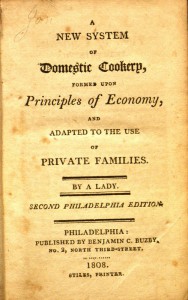 Maria Eliza Rundell (1745–1828) didn’t set out to be a domestic goddess. The widow of a surgeon, she collected recipes and household hints for her three married daughters. John Murray, a prominent publisher, happened to be a family friend, and Rundell gave him her recipe collection as a favor, expecting no financial reimbursement.
Maria Eliza Rundell (1745–1828) didn’t set out to be a domestic goddess. The widow of a surgeon, she collected recipes and household hints for her three married daughters. John Murray, a prominent publisher, happened to be a family friend, and Rundell gave him her recipe collection as a favor, expecting no financial reimbursement.
Murray published Rundell’s work in 1806 as A New System of Domestic Cookery, and Rundell became a housekeeping superstar, supplanted only by Mrs. Beeton in the 1860s. The book was an immediate success, especially in the United States, and went through over 65 editions in the next thirty years. Rundell focused on budget cooking and household management. Her recipes included dishes such as eel pie and calves’ foot broth, as well as more standard fare. This week’s recipe is an early example of Anglo-Indian cuisine, fostered by British contact with India through colonization and trade.
Chicken Curry
From A New System of Domestic Cookery
 Cut up the chickens before they are dressed, and fry them in butter, with sliced onions, till of a fine colour : or if you use those that have been dressed, do not fry them : lay the joints, cut in two or three pieces each into a stewpan, with veal or mutton gravy, a clove or two of garlick, four large spoonfuls of cream, and some Cayenne : rub smooth one or two spoonfuls of curry powder, with a little flour, and a bit of butter, and add twenty minutes before you serve ; stewing it on till ready. A little juice of lemon should be squeezed in when serving.
Cut up the chickens before they are dressed, and fry them in butter, with sliced onions, till of a fine colour : or if you use those that have been dressed, do not fry them : lay the joints, cut in two or three pieces each into a stewpan, with veal or mutton gravy, a clove or two of garlick, four large spoonfuls of cream, and some Cayenne : rub smooth one or two spoonfuls of curry powder, with a little flour, and a bit of butter, and add twenty minutes before you serve ; stewing it on till ready. A little juice of lemon should be squeezed in when serving.
Slices of rare done veal, rabbit or turkey, make a good curry.
A dish of rice boiled plain, as hereafter directed, must be always served to eat with curry.
See the full text at the Hathi Trust
Don’t miss Food Sense, the 2012 Life Sciences and Society Symposium, March 16-18. SCARaB is participating with an exhibition of books on science and nutrition, now open in the Ellis Library Colonnade.
 Food Revolutions is now on view in the Ellis Library Colonnade. From the four humors to the discovery of vitamins, this exhibition examines our changing notions of healthy eating over two centuries. Food Revolutions brings together medical books, cookbooks, scientific publications, and dieting texts to illustrate our ongoing quest for health, and our changing relationships with food.
Food Revolutions is now on view in the Ellis Library Colonnade. From the four humors to the discovery of vitamins, this exhibition examines our changing notions of healthy eating over two centuries. Food Revolutions brings together medical books, cookbooks, scientific publications, and dieting texts to illustrate our ongoing quest for health, and our changing relationships with food.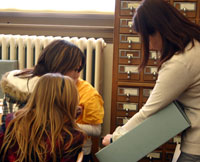 Lena Sheets has a master's degree in education and teaches world cultures at
Lena Sheets has a master's degree in education and teaches world cultures at 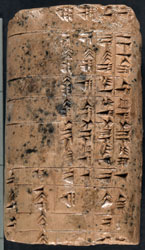
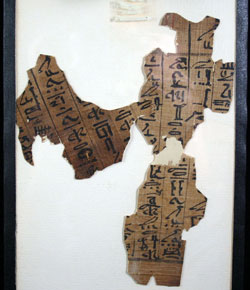 Any additional comments or suggestions?
Any additional comments or suggestions?
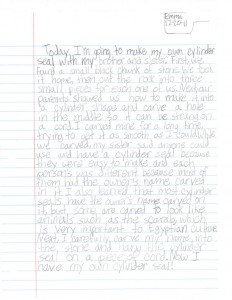

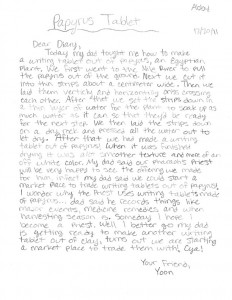
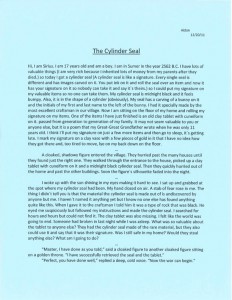


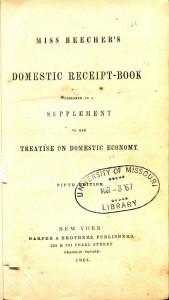 Catharine Beecher (1800-1878), the sister of the abolitionist Harriet Beecher Stowe, was an early feminist and advocate of women’s education. Beecher was at the forefront of the home economics movement in the nineteenth century. She sought to increase the status of traditional women’s work such as cooking and childcare, arguing for its value to society and the need for female education to inform this work.
Catharine Beecher (1800-1878), the sister of the abolitionist Harriet Beecher Stowe, was an early feminist and advocate of women’s education. Beecher was at the forefront of the home economics movement in the nineteenth century. She sought to increase the status of traditional women’s work such as cooking and childcare, arguing for its value to society and the need for female education to inform this work.
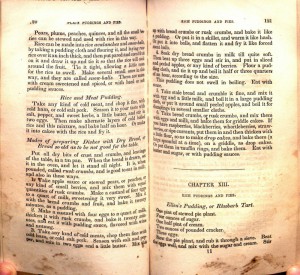
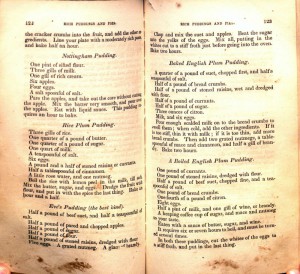
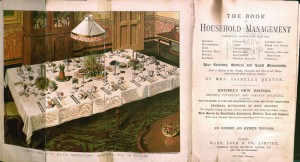 As the oldest girl in a family of twenty-one children, Isabella Mayson (1836–1865) had ample practice in the domestic arts by the time she married Samuel Beeton at the age of 20. Samuel was an innovative editor and publisher, and Isabella participated fully in his publishing business, putting her domestic skills to work as editor of the English Woman's Domestic Magazine. The year after her marriage, Isabella also began work on the monumental compendium of domestic science that is The Book of Household Management. The book was first published it in 1861, when Isabella was only 25, and it was an immediate success due to her attention to accuracy, economy, and taste.
As the oldest girl in a family of twenty-one children, Isabella Mayson (1836–1865) had ample practice in the domestic arts by the time she married Samuel Beeton at the age of 20. Samuel was an innovative editor and publisher, and Isabella participated fully in his publishing business, putting her domestic skills to work as editor of the English Woman's Domestic Magazine. The year after her marriage, Isabella also began work on the monumental compendium of domestic science that is The Book of Household Management. The book was first published it in 1861, when Isabella was only 25, and it was an immediate success due to her attention to accuracy, economy, and taste.
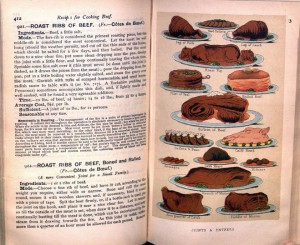
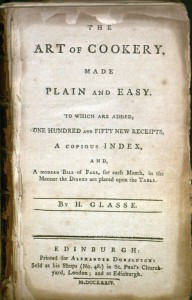 In March,Special Collections, Archives and Rare Books will be participating in
In March,Special Collections, Archives and Rare Books will be participating in 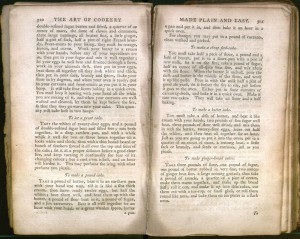
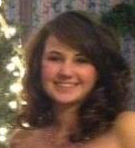 Jennifer Para is a freshman from Rogers, Arkansas, majoring in business. As part of
Jennifer Para is a freshman from Rogers, Arkansas, majoring in business. As part of 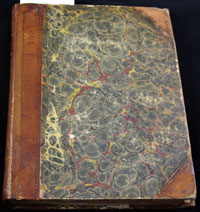 Glancing through rare books at Ellis Library, a certain leather bound novel with a delicate design imprinted into the spine catches your eye. The marbled paper cover reminds you of exquisite stones with white and gold specks reflecting the bouncing sun, meshed together in a pond of blood. Touching the book, you are surprised at its smoothness, and you wonder why the book does not fall apart at your caress. On the book’s spine you notice gold lettering revealing the title of the book: Aeneidos. This epic poem is a 1583 copy of Phaer and Twyne’s translation of Virgil’s Aeneid.
Glancing through rare books at Ellis Library, a certain leather bound novel with a delicate design imprinted into the spine catches your eye. The marbled paper cover reminds you of exquisite stones with white and gold specks reflecting the bouncing sun, meshed together in a pond of blood. Touching the book, you are surprised at its smoothness, and you wonder why the book does not fall apart at your caress. On the book’s spine you notice gold lettering revealing the title of the book: Aeneidos. This epic poem is a 1583 copy of Phaer and Twyne’s translation of Virgil’s Aeneid.
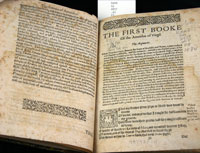 teen you find the authors’ letter to their readers. Phaer and Twyne intended their translation of the Aeneid to be read by “maisters and students of universities,” who “will not bee too much offended,” by their raw translation, and “pray they will correct the errors escaped in the printing.”
teen you find the authors’ letter to their readers. Phaer and Twyne intended their translation of the Aeneid to be read by “maisters and students of universities,” who “will not bee too much offended,” by their raw translation, and “pray they will correct the errors escaped in the printing.”
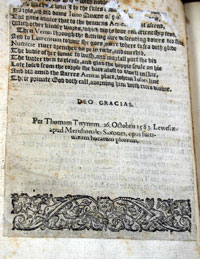 you see calligraphy and make out words “Hugh Bateman”, “Thomas Payne”, “1767 London”, “Dronfield”. Partaking in more research, you find record of several Hugh Batemans at Dronfield.
you see calligraphy and make out words “Hugh Bateman”, “Thomas Payne”, “1767 London”, “Dronfield”. Partaking in more research, you find record of several Hugh Batemans at Dronfield.

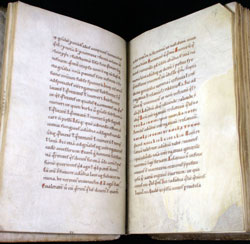 SC: What advice would you give to faculty or instructors interested in using Special Collections in their courses?
SC: What advice would you give to faculty or instructors interested in using Special Collections in their courses?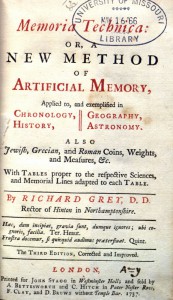 exams. Of course, Special Collections is always ready to help. This week, we’re sharing a 280-year-old secret from the
exams. Of course, Special Collections is always ready to help. This week, we’re sharing a 280-year-old secret from the 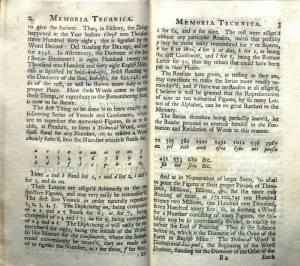 The words in brackets are the mnemonic devices, with the code at the end that represents the year in letters. If a student were called upon in an exam to produce an entire chronology of world events (as students often were in the eighteenth century), he could simply remember what Grey calls the “Memorial Line”: Diocleseko Mahomaudd Yezsid. Grey points out that the system is also adaptable to geography, astronomy, weights and measures, and the study of ancient coins.
The words in brackets are the mnemonic devices, with the code at the end that represents the year in letters. If a student were called upon in an exam to produce an entire chronology of world events (as students often were in the eighteenth century), he could simply remember what Grey calls the “Memorial Line”: Diocleseko Mahomaudd Yezsid. Grey points out that the system is also adaptable to geography, astronomy, weights and measures, and the study of ancient coins.
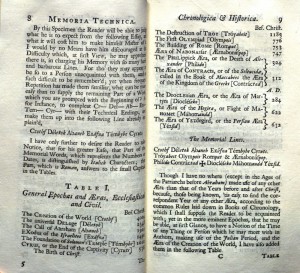 readers, his work was hugely popular in the eighteenth and nineteenth centuries. Memoria Technica remained in print for over 130 years, and was in fact the only pre-1800 book on memory to remain in use for so long.
readers, his work was hugely popular in the eighteenth and nineteenth centuries. Memoria Technica remained in print for over 130 years, and was in fact the only pre-1800 book on memory to remain in use for so long.